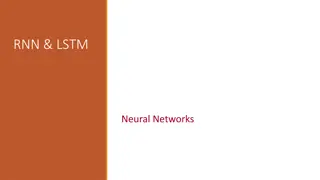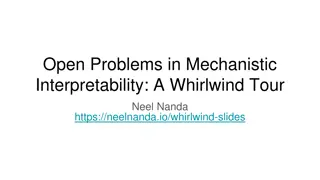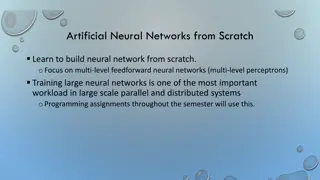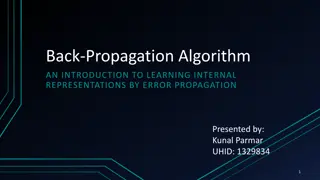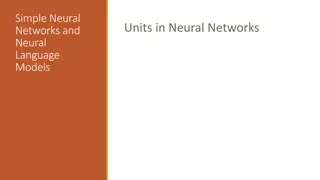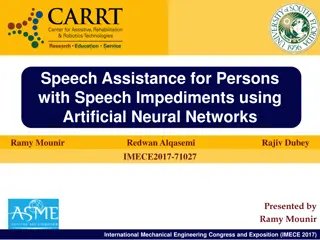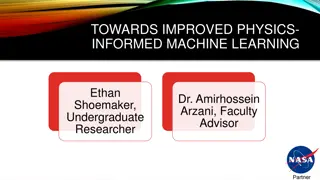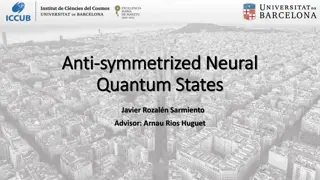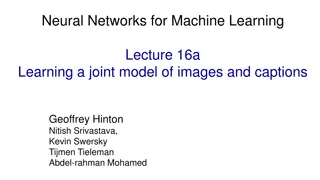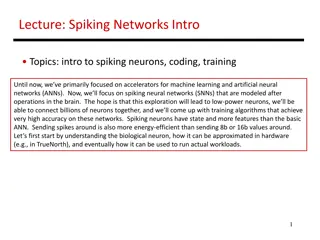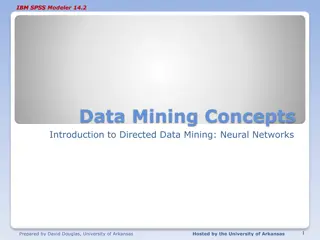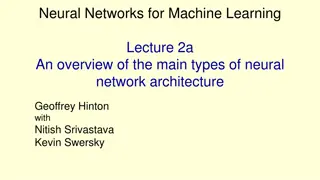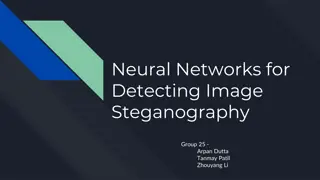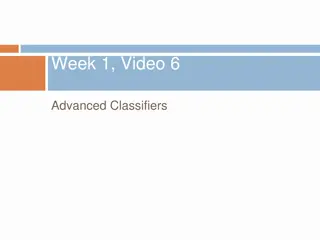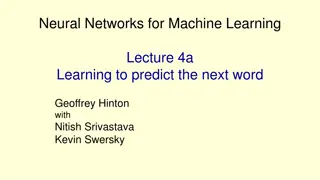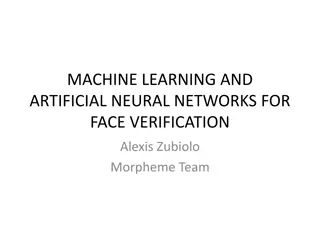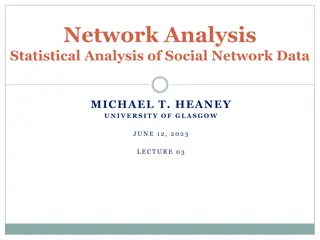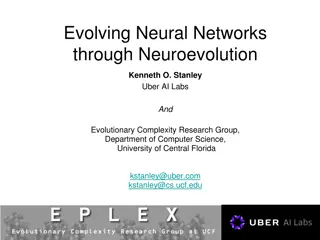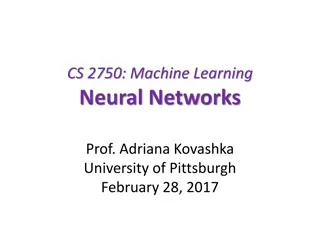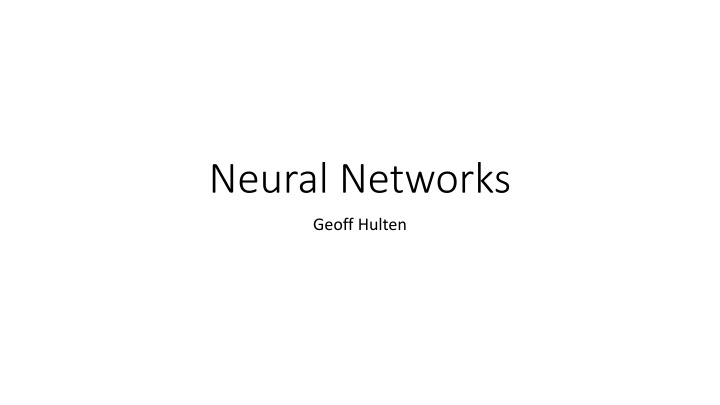
Understanding Neural Networks and Brain Functionality
Explore the fascinating world of neural networks and learn about the complexity of the human brain as seen through the lens of computer science. Dive into artificial neural networks, decision boundaries, prediction examples, and the importance of feature engineering in tasks like Blink.
Download Presentation

Please find below an Image/Link to download the presentation.
The content on the website is provided AS IS for your information and personal use only. It may not be sold, licensed, or shared on other websites without obtaining consent from the author. If you encounter any issues during the download, it is possible that the publisher has removed the file from their server.
You are allowed to download the files provided on this website for personal or commercial use, subject to the condition that they are used lawfully. All files are the property of their respective owners.
The content on the website is provided AS IS for your information and personal use only. It may not be sold, licensed, or shared on other websites without obtaining consent from the author.
E N D
Presentation Transcript
Neural Networks Geoff Hulten
The Human Brain (According to a computer scientist) Send electro-chemical signals Network of ~100 Billion Neurons Each ~1,000 10,000 connections Activation time ~10 ms second Image from Wikipedia ~100 Neuron chain in 1 second
Artificial Neural Network Grossly simplified approximation of how the brain works Artificial Neuron (Sigmoid Unit) Features used as input to an initial set of artificial neurons Output of artificial neurons used as input to others Output of the network used as prediction Mid 2010s image processing ~50-100 layers ~10-60 million artificial neurons 50 million into 100 billion 0.05%
Example Neural Network Fully connected network Single Hidden Layer ?0 2313 weights to learn 1 connection per pixel + bias ?0 ?0 1 connection per pixel + bias ?(? = 1) ?0 1 connection per pixel + bias 576 Pixels (Normalized) ?0 1 connection per pixel + bias 5 Weights 2,308 Weights Input Layer Hidden Layer Output Layer
Decision Boundary for Neural Networks Neural network with single node in output layer (no hidden layer) 20 Hidden Nodes 10 Hidden Nodes Concept Linear Model Non-linear decision boundary - Enabled by non-linear (sigmoid) activation - Complexity via network structure 6 Hidden Nodes Underfitting 4 Hidden Nodes 1 Layer Neural Network
Example of Predicting with Neural Network Sigmoid Function Hidden Layer ?0 0.5 ?1 -1.0 ?2 1.0 0.0 ~0.5 ?1 ?2 1.0 ? ? = 1 = ~0.82 1.5 0.5 ~0.75 1.0 ?0 0.25 ?1 1.0 ?0 1.0 ?2 1.0 ?1 0.5 Output Layer ?2 -1.0 Activations Input Layer
Very limited feature engineering on input Scale Normalize Example for Blink Task Hidden nodes learn useful features so you don t have to Trick is figuring out how many neurons to use and how to organize them Positive Weight? Weights from Hidden Node 1 ?(? = 1) Logistic Regression with responses as input Negative Weight? Input Image (Normalized) Weights from Hidden Node 2
Fully connected network Multi-Layer Neural Networks Two Hidden Layers 2333 weights to learn Filters on filters, for example maybe: Layer 1 learns eye shapes Layer 2 learns combinations 1 connection per pixel + bias 1 connection per pixel + bias ?(? = 1) 1 connection per pixel + bias Output Layer 576 Pixels (Normalized) 1 connection per pixel + bias 5 Weights Hidden Layer 2,308 Weights 20 Weights Hidden Layer
Decision Boundary for Multi-Layer Neural Networks 20 Hidden Nodes 20 Per Layer Did not converge 10 Hidden Nodes 10 Per Layer Concept Linear Model 6 Hidden Nodes 6 Per Layer Best Fit Much more powerful - Difficult to converge - Easy to overfit - Later lecture: how to adapt 4 Hidden Nodes 4 Per Layer 1 Hidden Layer Neural Network 2 Hidden Layer Neural Network
Output Layer Single network (training run), multiple tasks ? is a vector, not a single value Hidden nodes learn generally useful filters ?(?????????) ?(???????) ?(???????) 576 Pixels (Normalized) ?(? ???) Hidden Layer Output Layer
Neural Network Architectures/Concepts Fully connected layers Recurrent Networks (LSTM & attention) Convolutional Layers Embeddings MaxPooling Residual Networks Activation (ReLU) Batch Normalization Softmax Dropout Will explore in more detail later
Loss For Neural Networks In Book Use for Assignment ??????? < ? >,< ? > =1 ( ?? ?? )2 Mean Squared Error (MSE): 2 ? ??????? Cross Entropy (BCE): ??????? < ? >,< ? > = ?? ln( ??) + 1 ??ln(1 ??) ? ??????? 1 2 .5 12+ .1 02= .135 = ??????? < .5,.1 >,< 1,0 > B?????? < .5,.1 >,< 1,0 > = (ln .5 + ln 1 .1 ) = .795 ^ ^ ?1 ?2 ?1 .5 ?2 .1 ln .5 .69 .52= .25 ? 1 ? 1 0 ???? ??????? = ????(< ??>,< ??>) .1 .95 1 1 ?
Optimizing Neural Nets Back Propagation Gradient descent over entire network s weight vector Easy to adapt to different network architectures Converges to local minimum (usually won t find global minimum) Training can be very slow! For this week s assignment sorry For next week we ll use public neural network software In general very well suited to run on GPU
Conceptual Backprop with MSE 1. Forward Propagation ? ??? ????:? = ? ? ? 2. Back Propagation ? (?) ? ??? ? = ? ? (1 ? ? ) 3. Update Weights With MSE: ??= ?^(1 ?^)(? ?^) ? 1 ~0.5 2. Figure out how much each part contributes to the error. ?? ~0.82 ?1 ?2 ? 1.0 1. Figure out how much error the network makes on the sample: ????? ~?^ ? 0.5 ~0.75 1 ? 2 ???= ???????? ? = ? (1 ? ) ?? ?? ????????? 3. Step each weight to reduce the error it is contributing to ? ?.?= ? ? ??????
1. Forward Propagation Backprop Example 2. Back Propagation 3. Update Weights = 0.1 ?0 0.5 ?1 -1.0 ?2 1.0 ??= ?^(1 ?^)(? ?^) ??= 0.027 ? 1 ~0.5 ?? ~0.82 ?1 ?2 ? 1.0 Error = ~0.18 ?0 0.25 0.5 ?1 1.0 ~0.75 1 ???= ???????? ?2 1.0 ? 2 ??0= 0.0027 ??1= 0.0013 ??2= 0.0020 ? ?.? = ? ? ?????? ? 2.0= 0.0005 ? 2.1= 0.0005 ? 2.2= 0.00025 ?0 1.0 ?1 0.5 ? = ? (1 ? ) ? 2= ~.005 ?? ?? ?2 -1.0 ?????????
Backprop Algorithm Initialize all weights to small random number (-0.05 0.05) While not time to stop repeatedly loop over training data: Input a single training sample to network and calculate ??for every neuron Back propagate the errors from the output to every neuron ??= ?^(1 ?^)(? ?^) ? = ? (1 ? ) ??????????? ?? Downstream error This node s effect on error Update every weight in the network ???= ???????? ???= ??? + ??? Stopping Criteria: # of Epochs (passes through data) Training set loss stops going down Accuracy on validation data
Backprop with Hidden Layer (or multiple outputs) 1. Forward Propagation 2. Back Propagation 3. Update Weights ? 1,1= ? 1,1 1 ? 1,1 (?1,1 2,1?2,1 + ?1,1 2,2?2,2) ?1,1 2,1 ? 2,1 ? 1,1 ?1,1 2,2 ?? ?1 ?2 ? 1.0 0.5 1 ??= ???????? ? 2,2 ? 1,2 ??= ?^(1 ?^)(? ?^) ? = ? (1 ? ) ?? ?? ?????????
Stochastic Gradient Descent Gradient Descent Calculate gradient on all samples Step Per Sample Gradient Stochastic Gradient Descent Calculate gradient on some samples Step Stochastic can make progress faster (large training set) Stochastic takes a less direct path to convergence Batch Size: N instead of 1 Gradient Descent Stochastic Gradient Descent
Local Optimum and Momentum Local Optimum Why is this okay? In practice: Neural networks overfit Loss Momentum ??? = ??? + ? ??(? 1) Power through local optimums Converge faster (?) Parameters
Dead Neurons & Vanishing Gradients Neurons can die ? = ? (1 ? ) * <stuff> Large weights (positive or negative) cause gradients to vanish What causes this Poor initialization of weights Optimization that gets out of hand Input variables unnormalized ??????? 10 ~.99995 ??????? 20 ~.999999998 Test: Assert if this condition occurs
What should you do with Neural Networks? As a model (similar to others we ve learned) Fully connected networks Few hidden layers (1,2,3) A few dozen nodes per hidden layer Leveraging recent breakthroughs Understand standard architectures Get some GPU acceleration Get lots of data Do some feature engineering Normalization Craft a network architecture More on this next class Tune parameters # layers # nodes per layer Be careful of overfitting Simplify if not converging
Summary of Artificial Neural Networks Model that very crudely approximates the way human brains work Neural networks learn features (which we might have hand crafted without them) Each artificial neuron is a linear model, with non-linear activation function Many options for network architectures Backpropagation is a flexible algorithm to learn neural networks Neural networks are very expressive, can learn complex concepts (and overfit)



